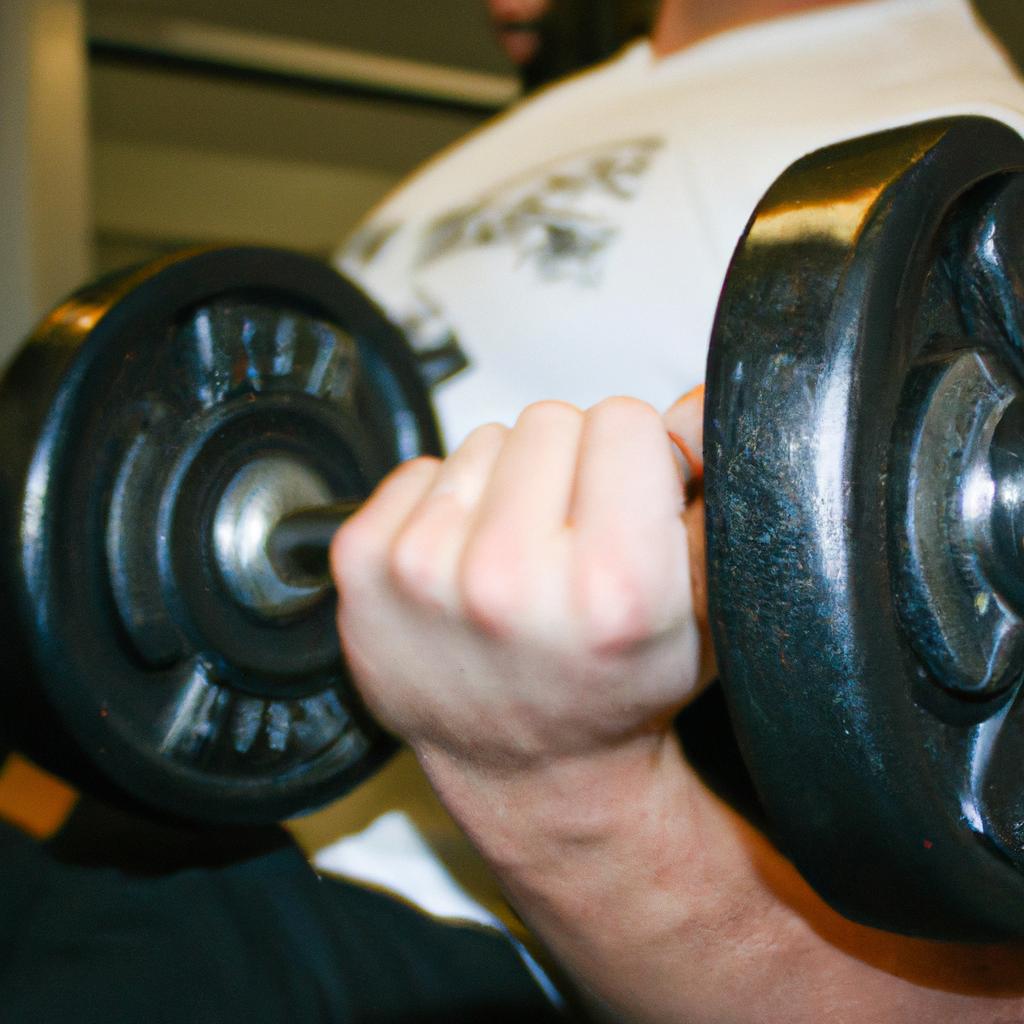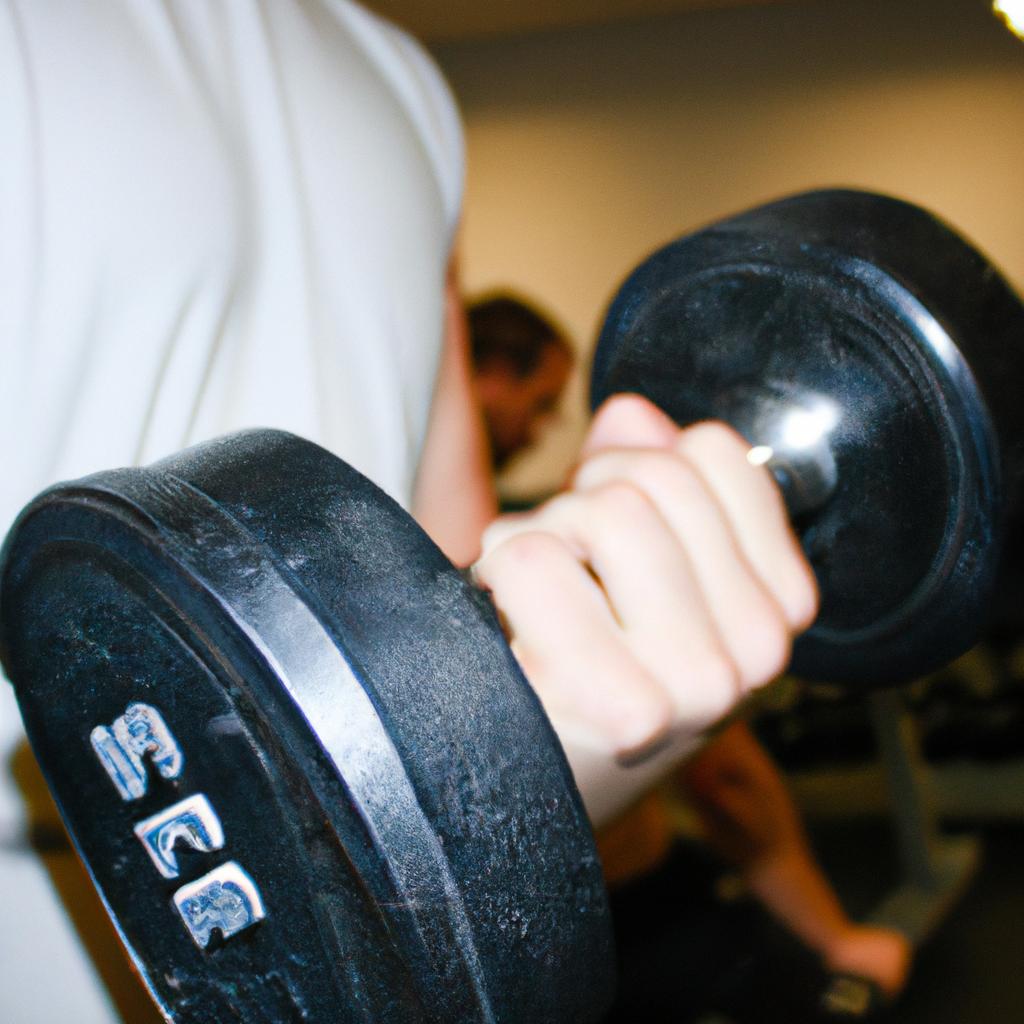Introduction
Muscle hypertrophy, the process of increasing muscle size and strength, is a key objective for many individuals in the fitness studio. Whether it be bodybuilders aiming to sculpt their physiques or athletes seeking enhanced performance, understanding the mechanisms behind muscle growth can provide valuable insights into optimizing training regimens. This article delves into the science of muscle hypertrophy, exploring the physiological factors that contribute to its development and discussing effective strategies for maximizing strength and size gains.
To illustrate the significance of muscle hypertrophy, consider an example of a hypothetical individual named Alex. Alex has been consistently attending weightlifting sessions at their local gym for several months but has noticed minimal progress in terms of increased muscularity. Despite putting in considerable effort during each workout session, they find themselves frustrated by their lack of visible results. By gaining insight into the underlying principles governing muscle hypertrophy, individuals like Alex can make informed decisions regarding exercise selection, volume, intensity, and other variables to optimize their training approach and unlock greater gains in both strength and size.
Understanding Muscle Hypertrophy
Imagine a dedicated fitness enthusiast named John. For the past year, John has been diligently hitting the gym, following a strict workout routine to increase his muscle size and strength. Despite all his efforts, he feels frustrated by the lack of progress he’s made. Little does John know that unlocking muscle hypertrophy—the process of increasing muscle size—is not just about lifting weights; it requires an understanding of the underlying mechanisms at play.
The Importance of Resistance Training:
To comprehend muscle hypertrophy, one must first grasp the significance of resistance training. Engaging in exercises like weightlifting stimulates mechanical tension within muscles, leading to microscopic damage in individual muscle fibers. The body then responds by initiating repair processes that involve protein synthesis and increased cell signaling for growth. This adaptation is essential to achieve gains in muscular size and strength.
Factors Influencing Muscle Hypertrophy:
Various factors influence the extent of muscle hypertrophy experienced by individuals engaging in resistance training. One crucial factor is progressive overload—gradually increasing the intensity or volume of workouts over time—to continually challenge muscles and promote further growth. Adequate nutrition is another vital aspect as consuming sufficient protein provides amino acids necessary for building new muscle tissue.
In addition, genetics play a role in determining an individual’s potential for muscle growth. Some people may naturally have a higher capacity for hypertrophy due to genetic variations affecting hormone levels, satellite cell activity, or fiber type composition. Lastly, proper recovery through adequate sleep and rest periods between workouts allows muscles to heal and grow more effectively.
Emotional Response Points:
- Increased motivation: Witnessing visible changes in physical appearance can boost self-confidence.
- Frustration: Lack of noticeable results despite hard work can lead to discouragement.
- Excitement: Learning about effective strategies for maximizing muscle growth can ignite enthusiasm.
- Curiosity: Understanding how various factors contribute to hypertrophy fuels curiosity about personal potential and possibilities.
Table on Factors Influencing Muscle Hypertrophy:
| Factor | Influence |
|---|---|
| Progressive Overload | Promotes continual challenge for muscles, leading to further growth |
| Adequate Nutrition | Provides essential amino acids needed for building new muscle tissue |
| Genetic Predisposition | Determines individual’s potential for hypertrophy due to variations in hormone levels, etc. |
| Proper Recovery | Allows muscles to heal and grow more effectively |
Transition into the subsequent section about “The Science Behind Muscle Growth”:
By comprehending the factors influencing muscle hypertrophy, individuals like John can optimize their training strategies to unlock their full potential. In the following section, we will delve deeper into the science behind muscle growth, exploring the physiological processes that occur during resistance training and understanding how they contribute to achieving significant gains in both strength and size.
The Science Behind Muscle Growth
To truly understand the process of muscle hypertrophy, it is essential to explore the underlying scientific principles that govern this remarkable phenomenon. Let’s delve deeper into the intricate mechanisms at play, which drive our muscles to adapt and grow stronger over time.
Imagine a scenario where an individual begins their fitness journey with a goal of increasing muscle size and strength. Through consistent resistance training, they subject their muscles to mechanical stress, causing microscopic damage to the muscle fibers. This initial stimulus acts as a catalyst for subsequent physiological adaptations within the body.
The science behind muscle growth can be summarized in three key steps:
-
Mechanical Stress: Intense exercise places strain on our muscles through repetitive contractions against external resistance. This physical stress induces microtears in the muscle fibers.
-
Metabolic Stress: As the damaged tissues repair themselves during rest and recovery periods, there is an increased release of metabolic byproducts such as lactate and hydrogen ions. These byproducts create an acidic environment surrounding the muscle cells, triggering additional cellular responses.
-
Muscular Damage: The inflammatory response initiated by muscular damage recruits various immune system components like white blood cells to clear away debris and initiate tissue repair processes. This phase leads to new protein synthesis and structural remodeling of existing proteins within the affected muscle fibers.
Consider these emotional implications associated with muscle growth:
- A sense of accomplishment when witnessing visible changes in one’s physique.
- Increased self-confidence due to improved functional abilities.
- Enhanced overall well-being derived from engaging in regular exercise.
- Inspiring others through personal transformation journeys.
Table: Key Factors for Muscle Hypertrophy
| Factor | Description |
|---|---|
| Progressive Overload | Gradually increasing training intensity or volume over time |
| Proper Nutrition | Adequate intake of macronutrients (protein, carbs, fats) |
| Sufficient Recovery | Allowing ample time for rest and recuperation between training sessions |
| Consistency | Maintaining a regular exercise routine |
As we explore the science behind muscle growth, it becomes evident that unlocking our body’s potential requires both physical exertion and strategic planning. In the subsequent section on “Key Factors for Muscle Hypertrophy,” we will delve into specific strategies to optimize your workout routines and further stimulate muscle growth. So let us now transition into understanding these key factors that contribute to maximizing hypertrophy gains.
Key Factors for Muscle Hypertrophy
Unlocking the potential for muscle hypertrophy requires an understanding of key factors that contribute to its growth. By examining these factors, individuals can optimize their training strategies and achieve significant gains in both strength and size. To illustrate this point, let’s consider a hypothetical case study: John, a dedicated fitness enthusiast who has been consistently weightlifting for several months but hasn’t experienced noticeable muscle growth.
One factor that plays a crucial role in muscle hypertrophy is progressive overload. This principle suggests that muscles must be continually subjected to increasingly challenging stimuli to promote growth. In other words, merely going through the motions of the same workout routine week after week may not elicit the desired results. For instance, John might benefit from gradually increasing his training volume by adding more weight or performing additional repetitions over time. By progressively overloading his muscles, he can stimulate them to adapt and grow.
Additionally, proper nutrition is essential for facilitating muscle hypertrophy. Consuming an adequate amount of protein is particularly important as it provides the building blocks necessary for muscle repair and growth. Furthermore, ensuring a calorie surplus can provide the energy required for intense workouts while also supporting muscular development. A well-balanced diet comprising lean proteins, complex carbohydrates, and healthy fats will help maximize John’s chances of achieving optimal muscle hypertrophy.
Furthermore, recovery plays a vital role in the process of muscle growth. During rest periods between workouts, muscles have an opportunity to repair themselves and become stronger. Neglecting sufficient rest and sleep can hinder progress by impeding this critical phase of adaptation. Incorporating active recovery techniques such as stretching or low-intensity cardio can aid in reducing muscle soreness while promoting blood flow and nutrient delivery to facilitate healing.
To evoke an emotional response among readers regarding the importance of these factors in unlocking their own potential for muscle hypertrophy:
- Proper nutrition fuels your body with what it needs to build powerful muscles.
- Progressive overload challenges your limits and pushes you beyond your comfort zone.
- Effective recovery allows for the growth and repair necessary to reach new levels of strength and size.
- Neglecting any of these factors can hinder progress and prevent you from achieving your desired results.
Table: The Key Factors for Muscle Hypertrophy
| Factor | Importance |
|---|---|
| Progressive Overload | Stimulates muscle adaptation |
| Nutrition | Provides building blocks |
| Recovery | Allows for repair and growth |
In conclusion, understanding the key factors that contribute to muscle hypertrophy is essential in unlocking one’s potential for increased strength and size. By incorporating progressive overload, maintaining proper nutrition, and allowing sufficient time for recovery, individuals like John can optimize their training strategies and achieve their fitness goals.
Optimal Training Techniques
To illustrate this further, let’s consider a hypothetical scenario of an individual named John who has been consistently weightlifting but struggles to see substantial gains in both strength and size.
To maximize muscle hypertrophy, several essential training techniques should be incorporated into one’s fitness regimen:
-
Progressive Overload: This technique involves progressively increasing the demands placed on your muscles over time. By gradually increasing resistance or intensity during workouts, you challenge your muscles beyond their current capacity, prompting them to adapt and grow stronger.
-
Exercise Variation: Incorporating a variety of exercises targeting specific muscle groups not only enhances overall muscular development but also prevents plateau effects. Changing up your routine regularly challenges different muscle fibers and ensures continuous growth stimulation.
-
Volume and Frequency: Increasing both volume (total sets and repetitions) and frequency (number of times per week you train each muscle group) can significantly impact muscle hypertrophy. Research suggests that higher volumes achieved through additional sets or increased workout frequency may yield greater muscle growth.
-
Tempo Manipulation: Controlling the speed at which you perform exercises can influence muscle adaptation. Applying eccentric-focused movements (slowing down the lowering phase) or utilizing varied tempos during exercise execution can provide unique stimuli for enhanced hypertrophic response.
In summary, by implementing these optimal training techniques, individuals like John can overcome plateaus and unlock new levels of strength and size gains within their fitness journey. However, effective progress relies not only on training methods but also on proper nutrition strategies tailored towards promoting muscle hypertrophy.
| Optimal Training Techniques |
|---|
| Progressive Overload |
| Exercise Variation |
| Volume and Frequency |
| Tempo Manipulation |
Moving forward, our next section will explore the crucial role of nutrition in supporting muscle hypertrophy. By understanding how to fuel your body adequately, you can optimize the benefits gained from these training techniques and maximize your muscle growth potential.
Nutrition for Muscle Hypertrophy
Transitioning from optimal training techniques, it is crucial to address the role of nutrition in promoting muscle hypertrophy. To illustrate the significance of proper nourishment, let us consider a hypothetical case study of an aspiring bodybuilder named Alex. Despite consistently following a rigorous workout routine that incorporates effective training techniques, Alex struggled to see significant gains in strength and size. However, upon adjusting his nutritional intake and adopting strategies specifically tailored towards muscle growth, he experienced notable improvements in both areas.
To maximize muscle hypertrophy, it is essential to understand the key principles of nutrition that support this process:
-
Sufficient Protein Intake:
- Consuming adequate protein promotes muscle protein synthesis.
- Aim for 0.7-0.9 grams of protein per pound of body weight daily.
- Include lean sources such as chicken breast, fish, tofu, or Greek yogurt.
-
Caloric Surplus:
- To build muscle mass effectively, an excess caloric intake is necessary.
- Consume more calories than you burn through physical activity.
- Focus on nutrient-dense foods like whole grains, fruits, vegetables, and healthy fats.
-
Carbohydrate Timing:
- Prioritize carbohydrates around your workouts.
- Consume complex carbs before exercising for sustained energy.
- Post-workout meals should include simple carbs to replenish glycogen stores.
-
Micronutrient Balance:
- Ensure sufficient intake of vitamins and minerals for overall health.
- A well-balanced diet with varied food sources can help achieve this goal.
Table: Macronutrient Distribution (per day)
| Daily Recommended Intake | |
|---|---|
| Protein | 20-35% of total calorie intake |
| Carbohydrates | 45-65% of total calorie intake |
| Fats | 20-35% of total calorie intake |
By incorporating these nutritional strategies, individuals like Alex can enhance their muscle hypertrophy journey. It is important to remember that nutrition alone cannot guarantee optimal results; it must be paired with appropriate training techniques.
Transitioning into the subsequent section about “Recovery and Rest,” understanding the significance of proper recovery methods will further contribute to maximizing muscle growth and overall performance.
Recovery and Rest
Transitioning from the importance of nutrition for muscle hypertrophy, it is crucial to emphasize the significance of recovery and rest in achieving optimal results. Consider the following scenario: imagine an individual who consistently follows a well-designed workout routine and consumes a nutrient-rich diet to support muscle growth. However, if this person neglects proper recovery strategies, such as adequate sleep and active rest days, their progress may be hindered.
To fully understand the role of recovery in muscle hypertrophy, let us delve into its various aspects. Firstly, sufficient sleep plays a vital role in allowing muscles to repair and grow. During deep sleep cycles, growth hormone secretion increases, promoting protein synthesis and overall tissue regeneration. Therefore, aiming for 7-9 hours of quality sleep per night can optimize muscle recovery and subsequent gains.
In addition to sleep, incorporating regular active rest days into one’s training regimen is essential. These days provide an opportunity for muscles to recover from intense workouts while still engaging in low-intensity activities that promote blood flow without causing further damage or fatigue. Examples of suitable active rest activities include light cardio exercises like walking or cycling, yoga sessions focused on flexibility and mobility work, or even foam rolling and stretching routines.
- Improved physical performance
- Reduced risk of injury
- Enhanced mental focus during workouts
- Increased motivation and adherence to exercise program
Furthermore, let us explore a three-column table showcasing different strategies individuals can implement to maximize their recovery:
| Recovery Strategy | Benefits | Implementation Tips |
|---|---|---|
| Adequate Sleep | – Promotes tissue regeneration | Ensure a consistent sleep schedule |
| – Enhances immune function | Create a comfortable sleeping environment | |
| Active Rest Days | – Facilitates muscle repair | Engage in low-impact activities |
| – Improves overall recovery | Listen to your body’s needs | |
| Mindfulness Practices | – Reduces stress and anxiety | Incorporate meditation or deep breathing exercises |
| – Enhances sleep quality | Practice mindfulness throughout the day |
By prioritizing recovery strategies such as proper sleep, active rest days, and incorporating mindfulness practices into one’s routine, individuals can optimize their muscle hypertrophy journey. It is crucial to acknowledge that a well-rounded approach to fitness goes beyond intense workouts and nutrition alone – it requires recognizing the importance of giving our bodies the necessary time and resources to recover and grow. With this holistic mindset, individuals can unlock their full potential in terms of both strength and size gains.




